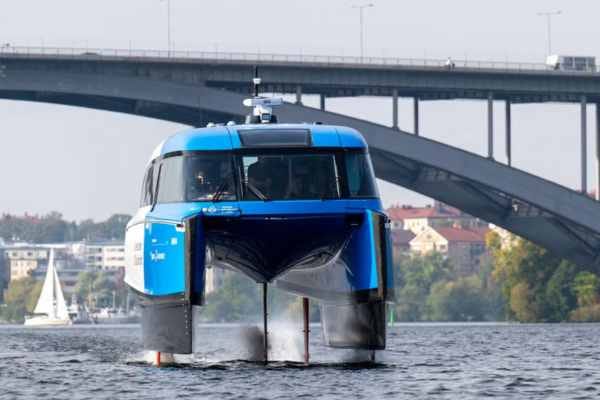An electric shift for commuters
Flying electric ferries and solar railway panels hint at the future of public transport.

Sustainable transport arrives in Europe as ferry and train networks glide their way toward an electric future.
Last week, Stockholm celebrated the maiden voyage of the world’s first electric hydrofoil commuter ferry, while train operators in Switzerland and Spain introduced innovative ways to generate free, green electricity. Let’s take a closer look at these groundbreaking projects.
Stockholm’s flying ferry
Sweden’s electric ‘flying’ hydrofoil ferry made its inaugural commuter run last week gliding a metre above the water from Tappström to Stockholm’s City Hall, completing the 15-km journey in just 30 minutes - half the time it would take by traditional ferry.
The route is a pilot project run by the Swedish startup Candela and Trafikverket to establish a low-emission transit alternative in Stockholm. Candela's P-12 ‘Nova’ aims to reshape urban transport by significantly cutting commute times and eliminating emissions on the water.
The startup was founded in 2014 by Gustav Hasselskog who was on a mission to develop electric boats with both range and speed.
“Traditional ferries are polluting, costly, and slow," Hasselskog said. "Our hydrofoil technology unlocks the potential of waterways, offering quicker, more comfortable, and cheaper journeys, reducing road congestion from Stockholm to New York to Bangkok.”
Equipped with innovative hydrofoil wings, Nova ‘flies’ above the water, reducing drag and, consequently, energy use by 80% and it has a simple charging process, using a regular car fast charger stationed at the City Hall.
Unlike conventional ferries, with fuel-powered engines and turbulent wakes, Nova’s hydrofoil design cuts more cleanly through the water enabling it to operate at higher speeds in the city centre, where speed restrictions limit other vessels.
Candela says it has received orders for P-12 ferries from a number of international customers from Berlin to those as far afield in Saudi Arabia and New Zealand.
Switzerland’s trackside solar
Switzerland has taken a novel approach to solar energy with its first removable solar power plant, integrated within railway tracks.
Developed by Swiss company Sun-Ways, this system slots solar panels into the gaps between rails, making the most of unused space without disrupting train operations or maintenance.
A pilot project is set to launch in spring 2025 in Neuchâtel, with a 100-metre photovoltaic installation on a railway line open to traffic. This project, approved following a review by the Swiss Federal Office of Transport, is designed to enhance solar energy production across Switzerland’s vast railway network.
Sun-Ways says similar projects are being planned for France, Spain amd South Korea, with potential partners in China, Thailand, Australia and the US.
Barcelona trains charge EVs
Barcelona’s MetroCHARGE program is transforming the city’s transit system into a renewable energy hub by repurposing energy generated from braking metro trains and harnessing solar power from rooftop panels on metro stations. This green energy is then directed into ultra-fast EV chargers, with the first charging station recently opening near the Bellvitge metro stop in L’Hospitalet de Llobregat.
Part of a larger city initiative to expand renewable-powered charging options, MetroCHARGE features seven high-speed charging lines across Barcelona. Each charger can power multiple EVs simultaneously, making use of energy that would otherwise go to waste and boosting sustainable transport infrastructure city-wide.





